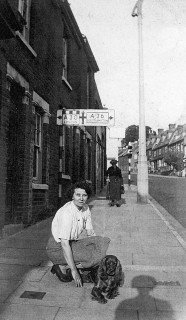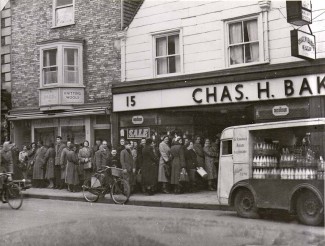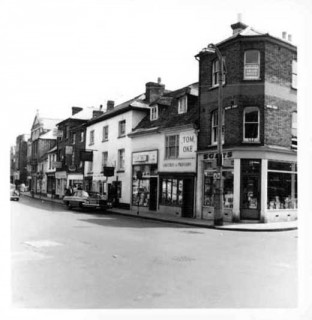Milford Street
Milford Street lies at the heart of the Milford Street Bridge Project. The underpass of the Ring Road, which crosses the top end of Milford Street, for many years had plain concrete walls. These are now adorned by the Project’s commemorative murals which give a glimpse of some of the life of the area before the Ring Road carved through the community.
The top photo shows how Milford Street looked before the Ring Road was built.
Many more memories have been shared by people who lived there. Here are just a few:
“And shops everywhere of course, we had everything. Supermarkets, we didn’t need them because who needed a supermarket when you had a grocer, a chemist, a baker, a greengrocer, everything within five minutes of your house”.
(Jean Moroney, born in 1932 and grew up on Milford Hill)
Michael and Doris Stefano had a banana warehouse in Milford Street as Jeremy ‘Frogg’ Moody remembers:
“As you walk past the Crystal Fountain on the right hand side you had a massive warehouse Fyffes, Fyffes Banana Warehouse, massive great big double wooden doors and you could smell the bananas, you know, even through the doors it was that strong, that was an abiding memory of mine”.
Some of Salisbury’s oldest established businesses are still trading in Milford Street today including Chas H Baker founded in 1902. The lower photo shows the shop in the 1950’s. Their “Sales” were obviously popular! Note the milk float in the foreground – a sight that has all but disappeared from city streets.
Some of the clearest Milford Street memories of the Project interviewees concern the mediaeval manor house at number 88; the Crystal Fountain pub, and Foster’s Bakery. You will find links for these on the right hand side of this page if you wish to read more.
The bottom half of the Street has retained many of its older buildings, but the top of the Street suffers from the destruction brought about by the Milford Street Bridge. It is now predominantly a commercial street with few residential houses, although several buildings today are offices rather than shops.
Sue Morrissey reflects on the closure of many businesses from the 1960s onwards in Milford Street:
“Then a lot of the little shops started to close and then when that started to happen the supermarkets started to spring up and that finished …. really, Milford Street altogether, and then we lost our little grocery stores, and our fruit and veg stores went, there were only sort of the hairdressers and Tills and places like that that were still surviving, but rest of it had gone, Tom Oke I think he was the last one to go, he was down near Scats and I think he held on to the last”.
You can read more about Milford Street in our Memory Walk.





No Comments
Add a comment about this page